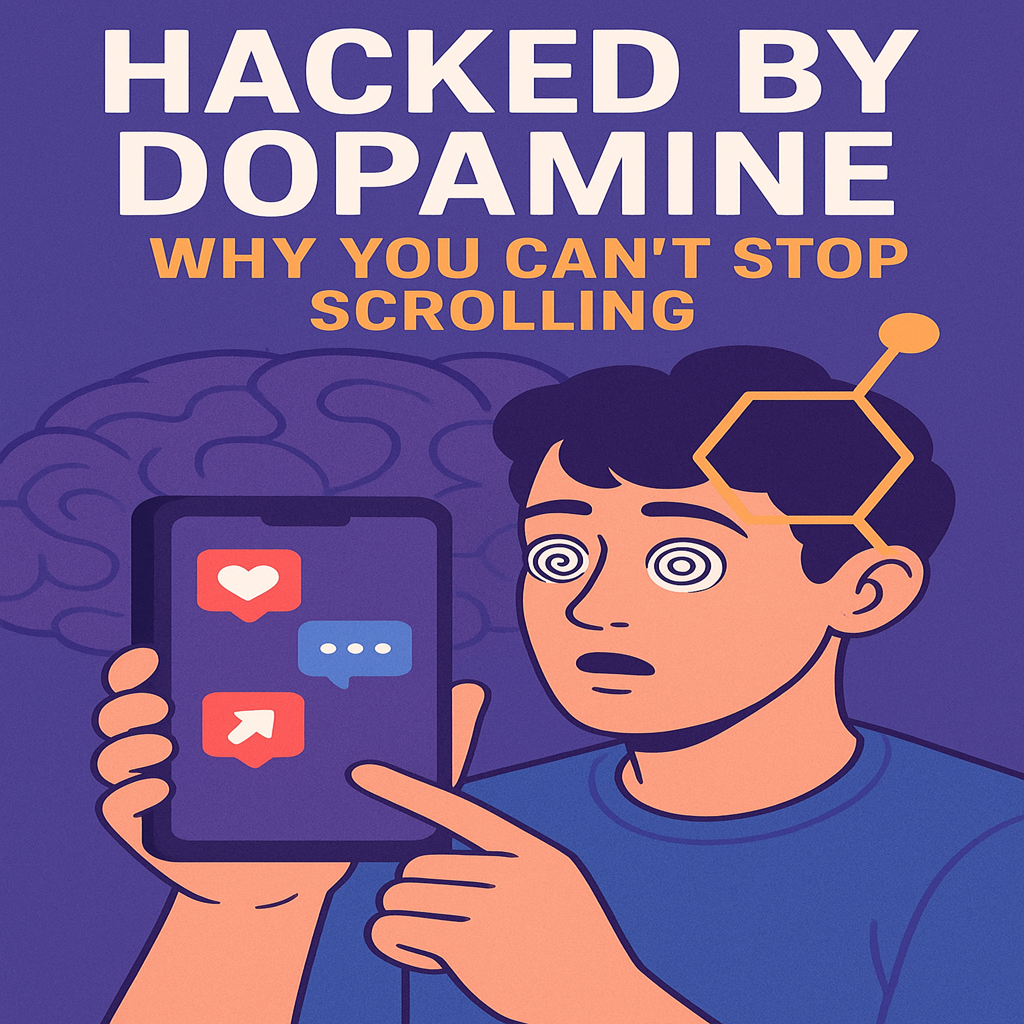
Inside the Neuroscience of Addiction in Social Media Design || The Endless Scroll Trap
It starts innocently enough. You pick up your phone to check one notification, and before you know it, an hour has disappeared into a blur of videos, memes, and posts. We tell ourselves “Just one more scroll”, but our brains seem wired to keep going, almost against our will.
This isn’t by accident. Social media platforms are built on neuroscience-backed design techniques that target the brain’s reward systems—especially one powerful chemical: dopamine.
In this article, we’ll break down how dopamine works, why it’s so addictive, and how social media companies have weaponized it to keep you hooked.
The Brain’s Reward System: A Quick Primer
To understand why scrolling feels so irresistible, we need to look at dopamine , often called the brain’s “pleasure chemical.” In reality, dopamine isn’t exactly about pleasure—it’s about motivation and anticipation. It’s the neurochemical that says:
“Something good is coming—keep going.”
When we anticipate a reward—whether it’s delicious food, a text from a crush, or a funny video—dopamine is released. This motivates us to seek out the reward again.
Key Facts About Dopamine:
- It’s about wanting, not just liking.
- It’s part of the mesolimbic pathway, which drives goal-oriented behavior.
- Variable, unpredictable rewards release more dopamine than consistent rewards.
This last point is crucial—because it’s the foundation of social media addiction.
Learn more about Trading psychology and how can Billionaires Success Secrets makes you expert in trading.
The Psychology of the Scroll
Social media platforms are designed to keep you engaged for as long as possible—becausemore engagement means more data, more ads, and more profit.
The primary weapon in their arsenal?
The variable reward system, a concept rooted in behavioral psychology.
Variable Rewards in Action
Psychologist B.F. Skinner discovered that unpredictable rewards make behavior much harder to stop.
- In his experiments, animals pressed levers for food pellets.
- When rewards were unpredictable, they pressed the lever obsessively.
Social media works the same way:
- Scrolling = pulling the lever.
- Occasional exciting posts = the reward.
Since you don’t know when the next post will make you laugh, shock you, or teach you something, you keep scrolling in anticipation.
The Infinite Scroll: The Perfect Dopamine Loop
When social media first began, users had to manually load the next page of posts. Then came infinite scroll —a feature pioneered by Aza Raskin in 2006. This feature eliminated stopping points. Without a natural break, your brain never gets a chance to ask: “Should I stop now?” From a neuroscience perspective, this:
Some platforms use psychological assessments, such as:
- Removes decision friction (less effort means more time spent).
- Keeps dopamine flowing by preventing mental pauses.
- Creates a seamless loop of anticipation.
Raskin himself later admitted the feature was addictive by design—and compared it to “behavioral cocaine.”
Likes, Comments, and Notifications: The Dopamine Currency
Every time your phone buzzes, your brain gets a dopamine spike in anticipation of what it might be:
- A friend’s reaction to your post?
- A new follower?
- A funny meme from a friend?
Why Notifications Are So Powerful:
- They’repersonalized linked to you, making them more emotionally impactful.
- They arriveunpredictably , triggering the variable reward system.
- They createsocial validation loopslikes and comments signal social approval, a deep evolutionary need.
- Platforms evendelay notifications strategically to maximize dopamine release. They know exactly when you’re most likely to check your phone.
The Role of Visual and Audio Cues
Social media doesn’t just rely on content to hook you—it uses sensory triggers that boost dopamine:
- Bright colors especially red for notifications) signal urgency.
- Animation effects (likes floating up, hearts popping) add micro-rewards.
- Sound effectscreate Pavlovian conditioning—just like a bell for a trained dog.
These small cues condition your brain to crave the act of checking your phone
Why Dopamine Feels Good but Can Be Dangerous
Dopamine-driven behavior is natural—it’s why we eat, explore, and learn. But when technology hijacks these systems, it can lead to:
- Time distortion(losing track of time).
- Reduced focuson offline goals
- Increased anxietywhen away from the device.
- Sleep disruptiondue to nighttime scrolling.
Over time, your brain adapts—requiring more stimulation for the same dopamine effect. This is similar to substance addiction patterns.
The Neuroscience of “Just One More”
The “just one more scroll” phenomenon is rooted in:
- Anticipation: The brain releases dopamine before the reward.
- Variable schedule reinforcement: You never know when you’ll see something amazing.
- Low effort, high potential reward:Minimal energy with possible big emotional payoff.
- Predictive models that warn couples of potential conflicts based on conversation analysis
This is why even when you feel mentally tired, your thumb keeps moving.
The Ethical Dilemma: Are We Being Controlled?
From a purely business perspective, social media addiction is a feature, not a bug.
- The longer you stay, the more ads you see.
- The more data they collect, the more money they make.
But here’s the ethical question:
At what point does “engagement” become manipulation?
Some insiders, like Tristan Harris (former Google design ethicist), argue that tech companies are in a race to the bottom of the brainstem —competing to capture and exploit basic human impulses.
Signs You’re Hooked on Dopamine Loops
- You check your phone first thing in the morning and last thing at night.
- You feel restless or anxious without internet access.
- You scroll without remembering why you opened the app.
- You lose track of time while browsing.
- You get a mood boost from likes and shares—but it fades quickly.
If several of these apply, you’re likely in a dopamine feedback loop.
Breaking Free: Practical Strategies
1. Introduce Friction
- Remove infinite scroll using browser extensions.
- Turn off auto-play for videos.
2. Change Notification Settings
- Disable non-essential notifications.
- Check apps on a schedule, not instantly.
3. Replace with Healthy Dopamine Sources
- Exercise, creative hobbies, in-person socializing.
4. Set Time Boundaries
- Use app timers.
- Keep the phone out of reach during meals and before bed.
The Future: Ethical Design or More Addiction?
Some platforms are introducing “time well spent”features—daily limits, reminders, and activity summaries.
However, as AI and personalization grow more advanced, dopamine hacking will get even more precise:
- Predicting exactly what content will trigger you.
- Delivering it at the perfect moment for maximum effect.
Unless ethical guidelines are enforced, the cycle may only deepen.
Learn more about How Ai is hacking your mind and why can't you stop scrolling due to to dopamine hit.
Conclusion: Awareness is Power
The science of dopamine is neither good nor bad—it’s simply how our brains evolved. But when that science is used to manipulate behavior for profit, we must recognize the game being played.
By understanding how and why we get hooked, we can take back control—choosing when to scroll, rather than letting algorithms choose for us.
Final thought:
Your attention is your most valuable currency. Spend it intentionally, not reactively.

